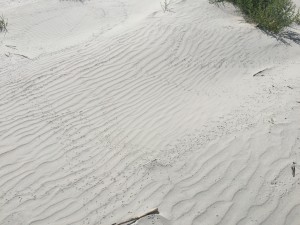These pale crabs live in burrows found along the high tide line and in the dunes. Ghost crabs will leave their burrows at dusk and are active until dawn, making daytime sightings an uncommon occurrence. Ghost Crabs prefer live prey and scavenge much less than other crabs, feasting on Sand Fleas, Mole Crabs, small clams, sea turtle eggs (!!), and other small animals. They in turn are eaten by animals such as shorebirds and raccoons.
- Pale square body with yellowish legs. Although the body of an mature adult is usually only two inches across, the long legs ake it appear considerably larger.
- One claw is larger than the other. The crab can run forward, backward, and sideways on its spindly legs.
- Smile! Periscope eyes on the ends of stalks that allow the crab to see 360 degrees.
- Pinkie sized burrow hole. The tunnel leading to the crab’s burrow may be four feet long.
- Burrow entrance with my size 8 for comparison.
- Retired behind a plug of sand. Ghost Crabs remain largely dormant in their burrows during the winter months.
- Much scampering about. Scarse, but not absent from our more popular beaches, you will observe many more burrow holes (and if you are lucky, the crabs themselves) on the more undisturbed beaches.
- Tracks in the dunes. Although the crabs live in the dry, upper beach, they are still marine animals and must venture to shallow ocean water to wet its gills.
- Tracks appear as six rows of widely spaced commas.












